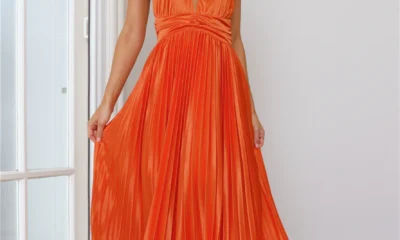FASHION
Clerical Collar: History, Significance, and Modern Use

The clerical collar is one of the most recognizable elements of religious attire, often symbolizing faith, humility, and service to the community. Traditionally worn by members of the clergy, the clerical collar has transcended its origins and remains an essential part of religious dress worldwide. While its design is simple, its meaning is profound. This article explores the history, significance, variations, and continued relevance of the clerical collar in modern religious practices.
What Is a Clerical Collar?
A clerical collar is a distinctive white collar worn by members of the clergy, typically encircling the neck. It is most often associated with Christian denominations, such as Catholic, Anglican, and Protestant churches.
The collar can be made of stiff white material or plastic and is often paired with a black shirt or cassock. It serves as a visible sign of an individual’s commitment to their religious vocation and role in serving their community.
The History of the Clerical Collar
The clerical collar has a rich history, dating back to the 19th century. Here’s a brief overview of its origins:
- Early Beginnings
- Before formalized clerical attire, clergy typically wore standard clothing that symbolized simplicity and modesty.
- Introduction of the Collar
- The modern clerical collar was introduced by Rev. Donald McLeod, a Scottish Anglican minister, in the mid-1800s. He designed the detachable white collar as part of the clerical dress.
- Symbol of Distinction
- Over time, the clerical collar became a symbol to distinguish clergy members from laypeople. It represented the separation of their sacred duties from secular life.
- Widespread Adoption
- By the late 19th and early 20th centuries, the clerical collar was widely adopted by clergy across denominations, including Catholic priests, Anglican ministers, and Protestant pastors.
Significance of the Clerical Collar
The clerical collar holds deep religious and cultural significance:
- Symbol of Service: The collar signifies a commitment to serve God and the community selflessly.
- Identification: It allows clergy members to be easily recognized by congregants and the public.
- Humility: Wearing a collar represents modesty and the renunciation of worldly vanity.
- Unity: Across denominations, the clerical collar fosters a sense of unity among clergy members.
- Authority: It symbolizes the spiritual authority and responsibilities entrusted to the clergy.
For many, the clerical collar serves as a reminder of the clergy’s mission to provide guidance, care, and support to those in need.
Types of Clerical Collars
There are several variations of the clerical collar, each serving specific needs or traditions. Here are the most common types:
1. Tab Collar
- Design: A small white tab is inserted into the front of the shirt collar.
- Use: Often worn with clerical shirts for everyday purposes.
- Practicality: Lightweight and easy to wear.
2. Full Collar (Roman Collar)
- Design: A stiff, circular white band that encircles the neck.
- Use: Commonly worn during formal services or liturgical events.
- Appearance: Traditional and highly recognizable.
3. Slip-In Collar
- Design: Similar to the tab collar but uses a slip-in mechanism.
- Use: Popular for its convenience and versatility.
4. Collarino
- Design: A white band worn inside a cassock, visible only as a strip around the neck.
- Use: Frequently worn in Catholic and Anglican traditions.
5. Detachable Collar
- Design: A removable collar that can be attached to a shirt or cassock.
- Use: Allows flexibility for cleaning and storage.
Each variation of the clerical collar provides functionality while honoring its symbolic purpose.
How Clerical Collars Are Worn
The clerical collar is often paired with specific attire that complements its religious significance. Here’s how it is typically worn:
- With a Clerical Shirt
- The collar is attached to a black or dark-colored clerical shirt, creating a sharp contrast that highlights the collar.
- Under a Cassock
- During formal occasions, such as church services or ceremonies, the collar is worn with a full-length cassock.
- With Liturgical Vestments
- In some traditions, the collar is part of a more elaborate outfit, including robes, stoles, or surplices.
- With Casual Attire
- Modern clergy may wear the collar with a simple shirt or jacket for informal settings or public events.
This versatility allows clergy members to adapt their attire based on the occasion while maintaining the collar’s significance.
Modern-Day Use of the Clerical Collar
The clerical collar remains relevant in contemporary society. While traditions evolve, the collar continues to fulfill its purpose:
- Public Identification: Clergy members wear the collar to signal their availability for pastoral care or support.
- Symbol of Hope: In times of crisis, clergy members wearing collars provide comfort and reassurance to communities.
- Ecumenical Representation: The collar is worn across denominations, signifying unity among Christian leaders.
- Modern Adaptations: Some clergy wear casual versions of the collar to connect with younger or diverse audiences.
Caring for a Clerical Collar
Proper maintenance of clerical collars ensures they remain clean and presentable. Follow these care tips:
- Clean Regularly
- Use a mild detergent to wash detachable collars. Avoid harsh chemicals that may damage the material.
- Remove Stains
- For tough stains, soak the collar in a mixture of baking soda and water before washing.
- Store Properly
- Keep collars in a clean, dry place to prevent discoloration or warping.
- Iron Carefully
- If needed, iron collars in a low-heat setting to maintain their shape.
- Replace When Worn
- Over time, collars may wear out. Replace them to ensure a professional appearance.
By caring for clerical collars, clergy members can maintain their symbolic significance and present a polished image.
The Clerical Collar in Other Religions and Contexts
While the clerical collar is most closely associated with Christianity, similar garments appear in other religious traditions.
- Rabbinical Collars: Some Jewish rabbis wear collars with traditional robes during ceremonies.
- Liturgical Garments: Clergy in various religions use symbolic clothing to represent their roles and commitments.
- Cultural Adaptations: In multicultural contexts, clergy may adapt the clerical collar to suit cultural attire or traditions.
This broad significance highlights the collar’s role as a symbol of leadership, service, and dedication.
Conclusion
The clerical collar is a powerful symbol of service, humility, and faith, deeply rooted in religious tradition. From its historical origins to its modern-day adaptations, the collar remains an essential element of clergy attire. Its significance transcends cultural and denominational boundaries, representing a visible sign of commitment to God and the community. By understanding its purpose, variations, and care, clergy members can honor this timeless tradition while fulfilling their sacred duties.
FAQs
What is the purpose of a clerical collar?
The clerical collar serves as a symbol of a clergy member’s commitment to their religious vocation and their role in serving the community.
Who wears clerical collars?
Clergy members, including priests, pastors, ministers, and deacons, wear clerical collars in various Christian denominations.
What is the difference between a tab collar and a Roman collar?
A tab collar features a small white tab in the front, while a Roman collar is a full circular band that encircles the neck.
Are clerical collars worn outside of church services?
Yes, clergy members often wear clerical collars during public events, pastoral care visits, and community outreach activities.
How do you clean a clerical collar?
Clerical collars can be cleaned with mild detergents and stored in a dry place to maintain their shape and appearance.
Is the clerical collar mandatory for clergy?
While not mandatory, the clerical collar is widely adopted as a symbol of faith, humility, and dedication among clergy members.

 BUSINESS8 months ago
BUSINESS8 months agoService Top: Understanding Role, Dynamics, and Consent in Relationships

 TECHNOLOGY7 months ago
TECHNOLOGY7 months agoSSIS 858: Everything You Need to Know

 GUIDE6 months ago
GUIDE6 months agoLookmovie2.to Legit: A Detailed Review of Safety and Features

 FASHION8 months ago
FASHION8 months agoDIY Tips to Customize Your Orange Prom Dress and Stand Out

 GUIDE7 months ago
GUIDE7 months agoTokybook: Your Gateway to the World of Audiobooks

 TECHNOLOGY7 months ago
TECHNOLOGY7 months agoUnderstanding Libgen: The Ultimate Free Ebook Library

 GUIDE8 months ago
GUIDE8 months agoLeague of Graphs: The Ultimate Guide to League of Legends Stats and Analysis

 GUIDE7 months ago
GUIDE7 months agoLook at All Those Chickens: The Story Behind the Viral Meme
















